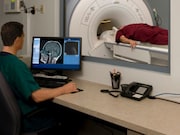High iron content of substantia nigra associated with worse long-term motor outcomes after stroke
TUESDAY, March 12, 2019 (HealthDay News) — Higher values of R2* (the magnetic resonance transverse relaxation rate) found in the substantia nigra (SN) likely reflect greater iron content and are associated with worse long-term outcomes after stroke, according to a study published online March 12 in Radiology.
Pierre Antoine Linck, M.D., from the Centre Hospitalier Universitaire de Bordeaux in France, and colleagues evaluated 181 participants, prospectively included from 2012 to 2015, with magnetic resonance imaging (MRI) to quantify SN R2* at 24 to 72 hours and at one year after stroke. To calculate an R2* asymmetry index (SN-AI), the SN was segmented bilaterally; greater SN-AI indicated greater relative R2* in the ipsilateral versus contralateral SN. The 95th percentile of R2* (SN-AI95) was compared based on infarct location.
The researchers found that if the ipsilateral striatum was infarcted, visual inspection, SN-AI95, and average maps consistently showed higher SN R2* at one year than if it was not (SN-AI95, 4.25 versus −0.88), but not at baseline. At one year, the striatal location of the infarct correlated with higher SN-AI95, independent of infarct volume, SN-AI95 at baseline, microbleeds, age, and sex (β = 4.99). At one year, striatum and insula, internal capsule, and external capsule were confirmed to correlate with higher SN-AI95 in voxel-based lesion-symptom mapping. There was an independent contribution for SN-AI95 to poor motor outcome.
“Our findings suggest utilization of iron-sensitive imaging with MRI may be useful to monitor neurodegeneration noninvasively within substantia nigra,” the authors write.
Copyright © 2019 HealthDay. All rights reserved.








